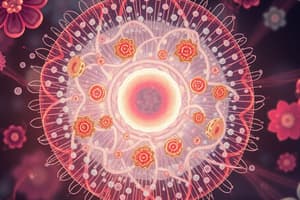Podcast
Questions and Answers
What is the function of microtubules in eukaryotic cells?
What is the function of microtubules in eukaryotic cells?
- Supporting the mitotic spindle during cell division
- Anchoring organelles and providing cell stability
- Aiding in cell movement and providing pathways for secretory vesicles (correct)
- Providing structure to the nuclear envelope and anchoring organelles
Which protein is primarily responsible for the formation of microfilaments?
Which protein is primarily responsible for the formation of microfilaments?
- Actin (correct)
- Tubulin
- Neurofilament
- Keratin
What is the main role of intermediate filaments in eukaryotic cells?
What is the main role of intermediate filaments in eukaryotic cells?
- Aiding in cell movement and providing pathways for secretory vesicles
- Anchoring organelles and providing cell stability (correct)
- Supporting the mitotic spindle during cell division
- Providing structure to the nuclear envelope and anchoring organelles
Which cytoskeleton component is involved in pulling homologous chromosomes apart during cell division?
Which cytoskeleton component is involved in pulling homologous chromosomes apart during cell division?
Which component of the cytoskeleton is known for being the thinnest?
Which component of the cytoskeleton is known for being the thinnest?
Which organelle is often referred to as the 'powerhouse' of the cell?
Which organelle is often referred to as the 'powerhouse' of the cell?
What is the main function of lysosomes in a cell?
What is the main function of lysosomes in a cell?
Which organelle is responsible for the modification, sorting, and packaging of proteins and lipids in a cell?
Which organelle is responsible for the modification, sorting, and packaging of proteins and lipids in a cell?
What is the function of the endoplasmic reticulum in a cell?
What is the function of the endoplasmic reticulum in a cell?
Which organelle stores genetic information in the form of DNA within a eukaryotic cell?
Which organelle stores genetic information in the form of DNA within a eukaryotic cell?
Flashcards are hidden until you start studying
Study Notes
Cell science, specifically the study of eukaryotic cells, involves understanding the structure and function of organelles within these cells. Eukaryotic cells are characterized by the presence of a nucleus and other membrane-bound organelles. The cytoskeleton, a network of protein fibers within the cytoplasm, plays a crucial role in maintaining cell stability and facilitating cell movement.
Cytoskeleton
The cytoskeleton is a dynamic structure that provides both the framework and motive force for cell movement. It consists of three major components: microtubules, intermediate filaments, and microfilaments.
Microtubules
Microtubules are small tubes made from the protein tubulin. They are found in structures like cilia and flagella, which are involved in cell movement. In addition, microtubules help provide pathways for secretory vesicles to move through the cell and are part of the mitotic spindle, which pulls homologous chromosomes apart during cell division.
Intermediate Filaments
Intermediate filaments are smaller than microtubules but larger than microfilaments. They are made of a variety of proteins, such as keratin and neurofilament. These filaments are very stable and help provide structure to the nuclear envelope and anchor organelles.
Microfilaments
Microfilaments are the thinnest part of the cytoskeleton and are made of actin. Actin is a highly conserved protein that is the most abundant protein in most eukaryotic cells. It is both flexible and strong, making it a useful protein in cell movement.
Organelles
Eukaryotic cells contain several organelles, each with a unique function. Some of the major organelles include the nucleus, mitochondria, lysosomes, the endoplasmic reticulum (ER), and the Golgi apparatus.
Nucleus
The nucleus is the central organelle that stores genetic information in the form of DNA. It is surrounded by a nuclear envelope, which is made up of two membranes and is perforated by nuclear pores that allow the movement of molecules in and out of the nucleus.
Mitochondria
Mitochondria are responsible for energy production within the cell. They generate ATP, the energy currency of the cell, through a process called cellular respiration. Mitochondria are often described as the "powerhouses" of the cell.
Lysosomes
Lysosomes are membrane-bound organelles that contain digestive enzymes. They break down waste materials and cellular debris, recycling the components back into the cell.
Endoplasmic Reticulum (ER)
The ER is a network of tubules and sheets that play a role in protein synthesis and lipid production. It is also involved in the modification and transport of proteins and lipids throughout the cell.
Golgi Apparatus
The Golgi apparatus is responsible for the modification, sorting, and packaging of proteins and lipids for transport out of the cell. It acts as a cellular post office, ensuring that the correct proteins and lipids are delivered to their intended destinations.
In summary, cell science focuses on the structure and function of organelles within eukaryotic cells. The cytoskeleton provides the structure and movement within the cell, while organelles like the nucleus, mitochondria, lysosomes, ER, and Golgi apparatus carry out specific cellular functions. Understanding these structures and functions is crucial for understanding the overall workings of a cell and the organism as a whole.
Studying That Suits You
Use AI to generate personalized quizzes and flashcards to suit your learning preferences.




